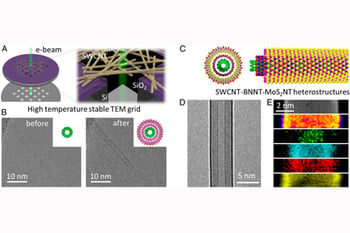PRESS RELEASE
- Research
- 2021
One-dimensional van der Waals heterostructures: Growth mechanism and handedness correlation revealed by nondestructive TEM
Authors
Yongjia Zheng, Akihito Kumamoto, Kaoru Hisama, Keigo Otsuka, Grace Wickerson, Yuta Sato, Ming Liu, Taiki Inoue, Shohei Chiashi , Dai-Ming Tang, Qiang Zhang, Anton Anisimov, Esko I. Kauppinen, Yan Li, Kazu Suenaga, Yuichi Ikuhara, Shigeo Maruyama, and Rong Xiang
Abstract
We recently synthesized one-dimensional (1D) van der Waals heterostructures in which different atomic layers (e.g., boron nitride or molybdenum disulfide) seamlessly wrap around a single-walled carbon nanotube (SWCNT) and form a coaxial, crystalized heteronanotube. The growth process of 1D heterostructure is unconventional—different crystals need to nucleate on a highly curved surface and extend nanotubes shell by shell—so understanding the formation mechanism is of fundamental research interest. In this work, we perform a follow-up and comprehensive study on the structural details and formation mechanism of chemical vapor deposition (CVD)–synthesized 1D heterostructures. Edge structures, nucleation sites, and crystal epitaxial relationships are clearly revealed using transmission electron microscopy (TEM). This is achieved by the direct synthesis of heteronanotubes on a CVD-compatible Si/SiO2 TEM grid, which enabled a transfer-free and nondestructive access to many intrinsic structural details. In particular, we have distinguished different-shaped boron nitride nanotube (BNNT) edges, which are confirmed by electron diffraction at the same location to be strictly associated with its own chiral angle and polarity. We also demonstrate the importance of surface cleanness and isolation for the formation of perfect 1D heterostructures. Furthermore, we elucidate the handedness correlation between the SWCNT template and BNNT crystals. This work not only provides an in-depth understanding of this 1D heterostructure material group but also, in a more general perspective, serves as an interesting investigation on crystal growth on highly curved (radius of a couple of nanometers) atomic substrates.
PNAS : https://www.pnas.org/content/118/37/e2107295118

